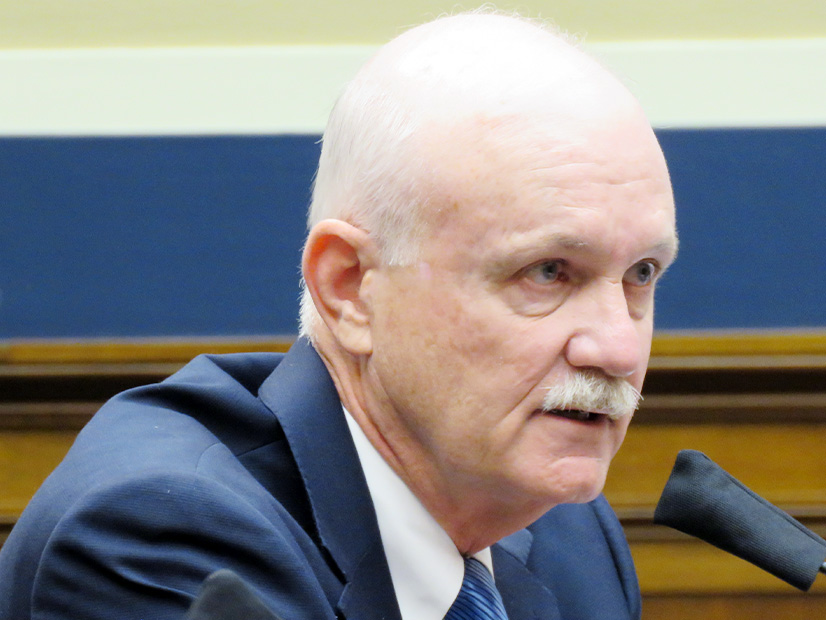WASHINGTON — FERC Chair Mark Christie wants to help bring down consumers’ power bills by addressing what has driven them up most in recent years: spending on the transmission and distribution system, he said at the National Association of State Energy Officials’ Energy Policy Outlook Conference.
“The last four years [have] seen the highest rate of inflation in people’s monthly power bills over the last 25 years,” Christie said Feb. 6. “That’s a fact. People are struggling depending on the power bills.”
Christie is accustomed to people complaining about their utility bills after 17 years as a state regulator in Virginia and since joining FERC in 2020. Natural gas prices shot up after Russia invaded Ukraine but have fallen back from that high.
But the transmission and distribution parts of consumer bills have been climbing. State regulators oversee the distribution system, and they also have some oversight of transmission. But FERC sets rates for the interstate commerce lines.
FERC regulates the RTOs, which have taken over the planning of transmission. But they often only lightly oversee smaller, “local projects,” as opposed to the more in-depth reviews the organized markets carry out in their regional planning efforts. RTOs, especially the large multistate markets, lack the resources to properly oversee all the local lines that come before them, Christie said.
“We have to build transmission to serve consumers, not to serve special interests,” he said.
Even if an RTO says a local line is needed, it is a healthy process to have a state regulator examine the project and what’s driving the need for it, he added.
“Go back and check your state laws — you need a strong, robust permitting process,” Christie told the room full of state officials.
State officials should pay attention to what their RTOs are doing and that involves working with state utility regulators, who already are engaged with the organized markets, Christie said.
Christie gave the standard disclaimer that he was talking about issues generally, and he did not mention any specific cases. But just before the holiday break, a major complaint seeking greater FERC oversight of local transmission was filed with the commission. (See Consumer Groups Seek Independent Oversight of Local Tx Planning.)
National Rural Electric Cooperative Association CEO Jim Matheson wrote Christie a letter Feb. 5 congratulating him on his elevation to chair and urging him to focus on affordability, among other issues. The co-op trade group supports Christie’s efforts to give states a bigger role in the planning of the grid on Order 1920-A and agreed that state regulators, and co-ops (that set their own rates for consumer-members), are the first line of defense from excessive transmission costs.
“Under Order 1920-A, there are significant holes in that line of defense where cooperative consumer-members are concerned, and we urge you to address this inequity in the future so that all consumers receive the protection they deserve,” Matheson said.
Christie Addresses Other Issues
An attendee asked about natural gas and electric coordination. Christie noted that while the power increasingly relies on the fuel as part of its baseload supply, gas generators still largely rely on just-in-time fuel delivery. One rule change that should be examined is whether they should be required to store fuel.
FERC has been working with the electric industry and the pipeline industry on improving gas coordination for years, and that work has seen progress, but Christie said that work could be expanded to bring in more entities.
“What about everyone else that needs gas?” Christie said. “We have manufacturers that need gas. And, of course, the LDC [local distribution companies] still need gas.”
Responding to another question on the rise of data centers and co-location with generation, Christie said every customer who uses power effectively is a cost-causer, whether it is a new residential account, or a massive data center with demand in the hundreds of gigawatts.
“We have gotten a bunch of cases regarding what’s called co-location,” Christie said. “I’ve said this publicly several times and I’ll say it again — we’re going to address it; we’re going to address it soon.”
FERC will handle the issues around data centers on the federal side, but ultimately, the facilities are customers of utilities, so states have a major role to play in the process of meeting their demand affordably, he added.



